Spatial Downscaling of GRACE Groundwater Storage Based on DTW Distance Clustering and an Analysis of Its Driving Factors
Abstract
1. Introduction
2. Materials and Methods
2.1. Study Area
2.2. Data Sources and Preprocessing
2.3. Methods
2.3.1. Water Balance Model
2.3.2. Hierarchical Clustering
2.3.3. K-Means Clustering
2.3.4. Distance Measurement Methods
2.3.5. RF Model
2.3.6. SVM Model
2.3.7. XGBoost Model
2.3.8. Ridge Regression Analysis
2.3.9. Accuracy Evaluation Metrics
3. Results
3.1. Feature Importance Analysis
3.2. Cluster Analysis
3.3. Model Accuracy Analysis
3.4. Accuracy Verification Analysis
3.4.1. Temporal and Spatial Consistency Analysis
3.4.2. Independent Validation with Monitoring Wells from 2019 to 2021
3.5. Driving Factor Analysis
3.5.1. Relative Contribution
3.5.2. Absolute Contribution
4. Discussion
4.1. Time Series Clustering’s Key Role in Improving GRACE Downscaling Accuracy
4.2. Regional Hydrological Process Spatial Heterogeneity and Its Driving Mechanisms
4.3. “Cluster First, Then Downscale” Strategy Advantages and Verification
4.4. Research Limitations and Future Prospects
5. Conclusions
- The innovative implementation of DTW distance measurement in conjunction with K-means time series clustering, resulting in a substantial enhancement of model correlation coefficients from approximately 0.1 without clustering to over 0.84 across all delineated subregions.
- The empirical validation through independent monitoring well data confirming that the correlation between downscaled GRACE data and measured well-water levels improved from a mean of 0.47 to 0.54 in region (a) and from 0.40 to 0.45 in region (b), substantiating the practical applicability and operational value of the proposed methodology.
- The demonstration that RF algorithms exhibit exceptional adaptability in spatially heterogeneous environments, thereby providing robust algorithmic selection evidence for subsequent investigations in related domains.
- The quantitative delineation of driving factor contributions through ridge regression analysis revealed differentiated groundwater change mechanisms across distinct subregions, with PET constituting the predominant factor in region (a) with a contribution of 33.70%, while NDVI emerged as the principal driver in region (b) with a contribution of 29.73%.
Author Contributions
Funding
Data Availability Statement
Conflicts of Interest
References
- Fu, L.L.; Pavelsky, T.; Cretaux, J.; Morrow, R.; Farrar, J.; Vaze, P.; Sengenes, P.; Vinogradova-Shiffer, N.; Sylvestre-Baron, A.; Picot, N.; et al. The Surface Water and Ocean Topography Mission: A Breakthrough in Radar Remote Sensing of the Ocean and Land Surface Water. Geophys. Res. Lett. 2024, 51, e2023GL107652. [Google Scholar] [CrossRef]
- Jiang, D.; Wang, J.; Huang, Y.; Zhou, K.; Ding, X.; Fu, J. The Review of GRACE Data Applications in Terrestrial Hydrology Monitoring. Adv. Meteorol. 2014, 24, 9. [Google Scholar] [CrossRef]
- Lawston, P.; Santanello, J.; Kumar, S. Irrigation Signals Detected from SMAP Soil Moisture Retrievals. Geophys. Res. Lett. 2017, 44, 11860–11867. [Google Scholar] [CrossRef]
- Getirana, A.; Rodell, M.; Kumar, S.; Beaudoing, H.; Arsenault, K.; Zaitchik, B.; Save, H.; Bettadpur, S. GRACE improves seasonal groundwater forecast initialization over the U.S. J. Hydrometeorol. 2019, 21, 59–71. [Google Scholar] [CrossRef] [PubMed]
- Rateb, A.; Scanlon, B.; Pool, D.; Sun, A.; Zhang, Z.; Chen, J.; Clark, B.; Faunt, C.; Haugh, C.; Hill, M.; et al. Comparison of Groundwater Storage Changes From GRACE Satellites With Monitoring and Modeling of Major U.S. Aquifers. J. Water Resour. Res. 2020, 56, e2020WR027556. [Google Scholar] [CrossRef]
- Kim, J.-S.; Seo, K.-W.; Kim, B.-H.; Ryu, D.; Chen, J.; Wilson, C. High-Resolution Terrestrial Water Storage Estimates From GRACE and Land Surface Models. Water Resour. Res. 2024, 60, e2023WR035483. [Google Scholar] [CrossRef]
- Bhanja, S.N.; Mukherjee, A. In situ and satellite-based estimates of usable groundwater storage across India: Implications for drinking water supply and food security. Adv. Water Resour. 2019, 126, 15–23. [Google Scholar] [CrossRef]
- Chen, C.; Chen, Q.; Qin, B.; Zhao, S.; Duan, Z. Comparison of Different Methods for Spatial Downscaling of GPM IMERG V06B Satellite Precipitation Product Over a Typical Arid to Semi-Arid Area. Front. Earth Sci. 2020, 8, 536337. [Google Scholar] [CrossRef]
- Yang, R.; Zhong, Y.; Zhang, X.; Maimaitituersun, A.; Ju, X. A Comparative Study of Downscaling Methods for Groundwater Based on GRACE Data Using RFR and GWR Models in Jiangsu Province, China. Remote Sens. 2025, 17, 493. [Google Scholar] [CrossRef]
- Yin, W.; Zhang, G.; Liu, F.; Zhang, D.; Zhang, X.; Chen, S. Improving the spatial resolution of GRACE-based groundwater storage estimates using a machine learning algorithm and hydrological model. Hydrogeol. J. 2022, 30, 3. [Google Scholar] [CrossRef]
- Gou, J.; Börger, L.; Schindelegger, M.; Soja, B. Downscaling GRACE-Derived Ocean Bottom Pressure Anomalies Using Self-Supervised Data Fusion. J. Geod. 2024, 99, 19. [Google Scholar] [CrossRef]
- Maxwell, A.; Warner, T.; Fang, F. Implementation of machine-learning classification in remote sensing: An applied review. Int. J. Remote Sens. 2018, 39, 2784–2817. [Google Scholar] [CrossRef]
- Jyolsna, P.; Kambhammettu, B.V.N.; Gorugantula, S. Application of random forest and multi linear regression methods in downscaling GRACE derived groundwater storage changes. Hydrol. Sci. J. 2021, 66, 874–887. [Google Scholar] [CrossRef]
- Ahmed, M.; Sultan, M.; Wahr, J.; Yan, E. The use of GRACE data to monitor natural and anthropogenic induced variations in water availability across Africa. Earth-Sci. Rev. 2014, 136, 289–300. [Google Scholar] [CrossRef]
- Yin, W.; Hu, L.; Zhang, M.; Wang, J.; Han, S.-C. Statistical Downscaling of GRACE-Derived Groundwater Storage Using ET Data in the North China Plain. J. Geophys. Res. Atmos. 2018, 123, 5973–5987. [Google Scholar] [CrossRef]
- Ning, S.; Ishidaira, H.; Wang, J. Statistical downscaling of GRACE-derived terrestrial water storage using satellite and GLDAS products. J. Jpn. Soc. Civ. Eng. Ser. B1 Hydraul. Eng. 2014, 70, I_133–I_138. [Google Scholar] [CrossRef] [PubMed]
- Yang, Y.; Long, D.; Guan, H.; Scanlon, B.; Simmons, C.; Jiang, L.; Xu, X. GRACE satellite observed hydrological controls on interannual and seasonal variability in surface greenness over Mainland Australia. J. Geophys. Res. Biogeosci. 2014, 119, 2245–2260. [Google Scholar] [CrossRef]
- Kong, R.; Zhang, Z.; Zhang, Y.; Yiming, W.; Peng, Z.; Chen, X.; Xu, C.-Y. Detection and Attribution of Changes in Terrestrial Water Storage across China: Climate Change versus Vegetation Greening. Remote Sens. 2023, 15, 3104. [Google Scholar] [CrossRef]
- Zheng, C.; Hu, G.; Chen, Q.; Jia, L. Impact of remote sensing soil moisture on the evapotranspiration estimation. Yaogan Xuebao J. Remote Sens. 2021, 25, 990–999. [Google Scholar] [CrossRef]
- Pang, Y.; Wu, B.; Cao, Y.; Jia, X. Spatiotemporal changes in terrestrial water storage in the Beijing-Tianjin Sandstorm Source Region from GRACE satellites. Int. Soil Water Conserv. Res. 2020, 8, 295–307. [Google Scholar] [CrossRef]
- McColl, K.A.; Alemohammad, S.H.; Akbar, R.; Konings, A.G.; Yueh, S.; Entekhabi, D. The global distribution and dynamics of surface soil moisture. Nat. Geosci. 2017, 10, 100–104. [Google Scholar] [CrossRef]
- Siyang, D.; Xue, X.; You, Q.; Peng, F. Remote sensing monitoring of the lake area changes in the Qinghai-Tibet Plateau in recent 40 years. J. Lake Sci. 2014, 26, 535–544. [Google Scholar] [CrossRef] [PubMed]
- Pascal, C.; Ferrant, S.; Selles, A.; Maréchal, J.-C.; Paswan, A.; Merlin, O. Evaluating downscaling methods of GRACE data: A case study over a fractured crystalline aquifer in South India. Hydrol. Earth Syst. Sci. Discuss. 2022, 26, 1–25. [Google Scholar]
- Hu, B.; Wang, L.; Li, X.; Zhou, J.; Pan, Y. Divergent Changes in Terrestrial Water Storage Across Global Arid and Humid Basins. Geophys. Res. Lett. 2021, 48, e2020GL091069. [Google Scholar] [CrossRef]
- Pohjankukka, J.; Pahikkala, T.; Nevalainen, P.; Heikkonen, J. Estimating the Prediction Performance of Spatial Models via Spatial k-Fold Cross Validation. Int. J. Geogr. Inf. Sci. 2020, 31, 2001–2019. [Google Scholar] [CrossRef]
- Meyer, H.; Reudenbach, C.; Wöllauer, S.; Nauss, T. Importance of spatial predictor variable selection in machine learning applications—Moving from data reproduction to spatial prediction. Ecol. Model. 2019, 411, 108815. [Google Scholar] [CrossRef]
- Tefera, G.W.; Ray, R.L.; Wootten, A.M. Evaluation of statistical downscaling techniques and projection of climate extremes in central Texas, USA. Weather. Clim. Extrem. 2024, 43, 100637. [Google Scholar] [CrossRef]
- Li, H.; Pan, Y.; Yeh, P.J.-F.; Zhang, C.; Huang, Z.; Xu, L.; Wang, H.; Zeng, L.; Gong, H.; Famiglietti, J.S. A New GRACE Downscaling Approach for Deriving High-Resolution Groundwater Storage Changes Using Ground-Based Scaling Factors. Water Resour. Res. 2024, 60, e2023WR035210. [Google Scholar] [CrossRef]
- Shilengwe, C.; Banda, K.; Nyambe, I. Machine learning downscaling of GRACE/GRACE-FO data to capture spatial-temporal drought effects on groundwater storage at a local scale under data-scarcity. Environ. Syst. Res. 2024, 13, 38. [Google Scholar] [CrossRef]
- Alarcón, D.; Suhogusoff, A.; Ferrari, L. Characterization of groundwater storage changes in the Amazon River Basin based on downscaling of GRACE/GRACE-FO data with machine learning models. Sci. Total Environ. 2023, 912, 168958. [Google Scholar] [CrossRef] [PubMed]
- Sahour, H.; Sultan, M.; Vazifedan, M.; Abdelmohsen, K.; Karki, S.; Yellich, J.A.; Gebremichael, E.; Alshehri, F.; Elbayoumi, T.M. Statistical Applications to Downscale GRACE-Derived Terrestrial Water Storage Data and to Fill Temporal Gaps. Remote Sens. 2020, 12, 533. [Google Scholar] [CrossRef]
- Save, H.; Bettadpur, S.; Tapley, B.D. High-resolution CSR GRACE RL05 mascons. J. Geophys. Res. Solid Earth 2016, 121, 7547–7569. [Google Scholar] [CrossRef]
- Han, K.; Wang, Y.; Chen, H.; Chen, X.; Guo, J.; Liu, Z.; Tang, Y.; Xiao, A.; Xu, C.; Xu, Y.; et al. A Survey on Vision Transformer. IEEE Trans. Pattern Anal. Mach. Intell. 2023, 45, 87–110. [Google Scholar] [CrossRef] [PubMed]
- Wang, L.; Zhang, Y. Filling GRACE data gap using an innovative transformer-based deep learning approach. Remote Sens. Environ. 2024, 315, 114465. [Google Scholar] [CrossRef]
- Rodell, M.; Houser, P.; Jambor, U.E.A.; Gottschalck, J.; Mitchell, K.; Meng, J.; Arsenault, K.; Brian, C.; Radakovich, J.; Mg, B.; et al. The Global Land Data Assimilation System. Bull. Am. Meteorol. Soc. 2004, 85, 381–394. [Google Scholar] [CrossRef]
- Ran, X.; Xi, Y.; Lu, Y.; Wang, X.; Lu, Z. Comprehensive survey on hierarchical clustering algorithms and the recent developments. Artif. Intell. Rev. 2022, 56, 8219–8264. [Google Scholar] [CrossRef]
- Ikotun, A.M.; Ezugwu, A.E.; Abualigah, L.; Abuhaija, B.; Heming, J. K-means clustering algorithms: A comprehensive review, variants analysis, and advances in the era of big data. Inf. Sci. 2023, 622, 178–210. [Google Scholar] [CrossRef]
- Cosentino, R.; Balestriero, R.; Bahroun, Y.; Sengupta, A.; Baraniuk, R.; Aazhang, B. Spatial Transformer K-Means. In Proceedings of the 2022 56th Asilomar Conference on Signals, Systems, and Computers, Pacific Grove, CA, USA, 31 October–2 November 2022; pp. 1444–1448. [Google Scholar]
- Zhang, Z.; Murtagh, F.; Van Poucke, S.; Lin, S.; Lan, P. Hierarchical cluster analysis in clinical research with heterogeneous study population: Highlighting its visualization with R. Ann. Transl. Med. 2017, 5, 75. [Google Scholar] [CrossRef] [PubMed]
- Zhang, Q.; Zhang, C.; Cui, L.; Han, X.; Jin, Y.; Xiang, G.; Shi, Y. A method for measuring similarity of time series based on series decomposition and dynamic time warping. Appl. Intell. 2022, 53, 6448–6463. [Google Scholar] [CrossRef]
- Zhao, J.; Itti, L. shapeDTW: Shape Dynamic Time Warping. Pattern Recognit. 2018, 74, 171–184. [Google Scholar] [CrossRef]
- Breiman, L. Random Forests. Mach. Learn. 2001, 45, 5–32. [Google Scholar] [CrossRef]
- Sun, W.; Chang, C.; Long, Q. Bayesian Non-linear Support Vector Machine for High-Dimensional Data with Incorporation of Graph Information on Features. In Proceedings of the 2019 IEEE International Conference on Big Data (Big Data) 2019, Los Angeles, CA, USA, 9–12 December 2019; Volume 2019, pp. 4874–4882. [Google Scholar]
- Chen, T.; Guestrin, C. XGBoost: A Scalable Tree Boosting System. In Proceedings of the 22nd ACM Sigkdd International Conference on Knowledge Discovery and Data Mining, San Francisco, CA, USA, 13–17 August 2016; pp. 785–794. [Google Scholar]
- Akiba, T.; Sano, S.; Yanase, T.; Ohta, T.; Koyama, M. Optuna: A Next-generation Hyperparameter Optimization Framework. In Proceedings of the 25th ACM SIGKDD International Conference on Knowledge Discovery & Data Mining, Anchorage, AK, USA, 4–8 August 2019; pp. 2623–2631. [Google Scholar]
- Zhao, Y.; Chen, Y.; Wu, C.; Li, G.; Ma, M.; Fan, L.; Zheng, H.; Song, L.; Tang, X. Exploring the contribution of environmental factors to evapotranspiration dynamics in the Three-River-Source region, China. J. Hydrol. 2023, 626, 130222. [Google Scholar] [CrossRef]
- Söküt Açar, T. Identification of Leverage Points in Principal Component Regression and r-k Class Estimators with AR(1) Error Structure. J. Adv. Res. Nat. Appl. Sci. 2020, 6, 353–363. [Google Scholar] [CrossRef]
- Hengl, T.; Nussbaum, M.; Wright, M.; Heuvelink, G.; Graeler, B. Random Forest as a generic framework for predictive modeling of spatial and spatio-temporal variables. PeerJ 2018, 6, e5518. [Google Scholar] [CrossRef] [PubMed]
- Scanlon, B.; Keese, K.; Flint, A.; Flint, L.; Gaye, C.B.; Edmunds, W.; Simmers, I. Global synthesis of groundwater recharge in semiarid and arid regions. Hydrol. Process. 2006, 20, 3335–3370. [Google Scholar] [CrossRef]
- Jasechko, S.; Seybold, H.; Perrone, D.; Fan, Y.; Kirchner, J. Widespread potential loss of streamflow into underlying aquifers across the USA. Nature 2021, 591, 391–395. [Google Scholar] [CrossRef] [PubMed]
- Sophocleous, M. Interactions Between Groundwater and Surface Water: The State of the Science. Hydrogeol. J. 2002, 10, 52–67. [Google Scholar] [CrossRef]
- Taylor, R.; Scanlon, B.; Doell, P.; Rodell, M.; Beek, R.; Wada, Y.; Longuevergne, L.; Leblanc, M.; Famiglietti, J.; Edmunds, M.; et al. Ground water and climate change. Nat. Clim. Change 2013, 3, 322–329. [Google Scholar] [CrossRef]
- Fan, Y.; Li, H.; Miguez-Macho, G. Global Patterns of Groundwater Table Depth. Science 2013, 339, 940–943. [Google Scholar] [CrossRef] [PubMed]
- Cuthbert, M.; Gleeson, T.; Moosdorf, N.; Befus, K.; Schneider, A.; Hartmann, J.; Lehner, B. Global patterns and dynamics of climate–groundwater interactions. Nat. Clim. Change 2019, 9, 137–141. [Google Scholar] [CrossRef]
- Macdonald, A.; Lark, R.; Taylor, R.; Abiye, T.; Fallas, H.; Favreau, G.; Goni, I.; Kebede, S.; Scanlon, B.; Sorensen, J.; et al. Mapping groundwater recharge in Africa from ground observations and implications for water security. Environ. Res. Lett. 2021, 16, 034012. [Google Scholar] [CrossRef]
- Sun, A.Y.; Scanlon, B.R. How can Big Data and machine learning benefit environment and water management: A survey of methods, applications, and future directions. Environ. Res. Lett. 2019, 14, 073001. [Google Scholar] [CrossRef]
- Famiglietti, J.S.; Rodell, M. Water in the Balance. Science 2013, 340, 1300–1301. [Google Scholar] [CrossRef] [PubMed]
- Tapley, B.; Watkins, M.; Flechtner, F.; Reigber, C.; Bettadpur, S.; Rodell, M.; Sasgen, I.; Famiglietti, J.; Landerer, F.; Chambers, D.; et al. Contributions of GRACE to understanding climate change. Nat. Clim. Change 2019, 5, 358–369. [Google Scholar] [CrossRef] [PubMed]
- Rodell, M.; Famiglietti, J.; Wiese, D.; Reager, J.T.; Beaudoing, H.; Landerer, F.; Lo, M.-H. Emerging trends in global freshwater availability. Nature 2018, 557, 651–659. [Google Scholar] [CrossRef] [PubMed]
- Li, H.; Pan, Y.; Huang, Z.; Zhang, C.; Xu, L.; Gong, H.; Famiglietti, J. A new GRACE downscaling approach for deriving high-resolution groundwater storage changes using ground-based scaling factors. ESS Open Arch. 2023. preprint. [Google Scholar] [CrossRef]
- Ziolkowska, J. Shadow price of water for irrigation—A case of the High Plains. Agric. Water Manag. 2015, 153, 20–31. [Google Scholar] [CrossRef]
- Xiao, M.; Koppa, A.; Mekonnen, Z.; Pagán, B.; Zhan, S.; Cao, Q.; Aierken, A.; Lee, H.; Lettenmaier, D. How much groundwater did California’s Central Valley lose during the 2012–2016 drought? Geophys. Res. Lett. 2017, 44, 4872–4879. [Google Scholar] [CrossRef]
- Mohtaram, A.; Shafizadeh-Moghadam, H.; Ketabchi, H. Reconstruction of total water storage anomalies from GRACE data using the LightGBM algorithm with hydroclimatic and environmental covariates. Groundw. Sustain. Dev. 2024, 26, 101260. [Google Scholar] [CrossRef]
- Sun, Z.; Long, D.; Yang, W.; Li, X.; Pan, Y. Reconstruction of GRACE data on changes in total water storage over the global land surface and sixty basins. Water Resour. Res. 2020, 56, e2019WR026250. [Google Scholar] [CrossRef]


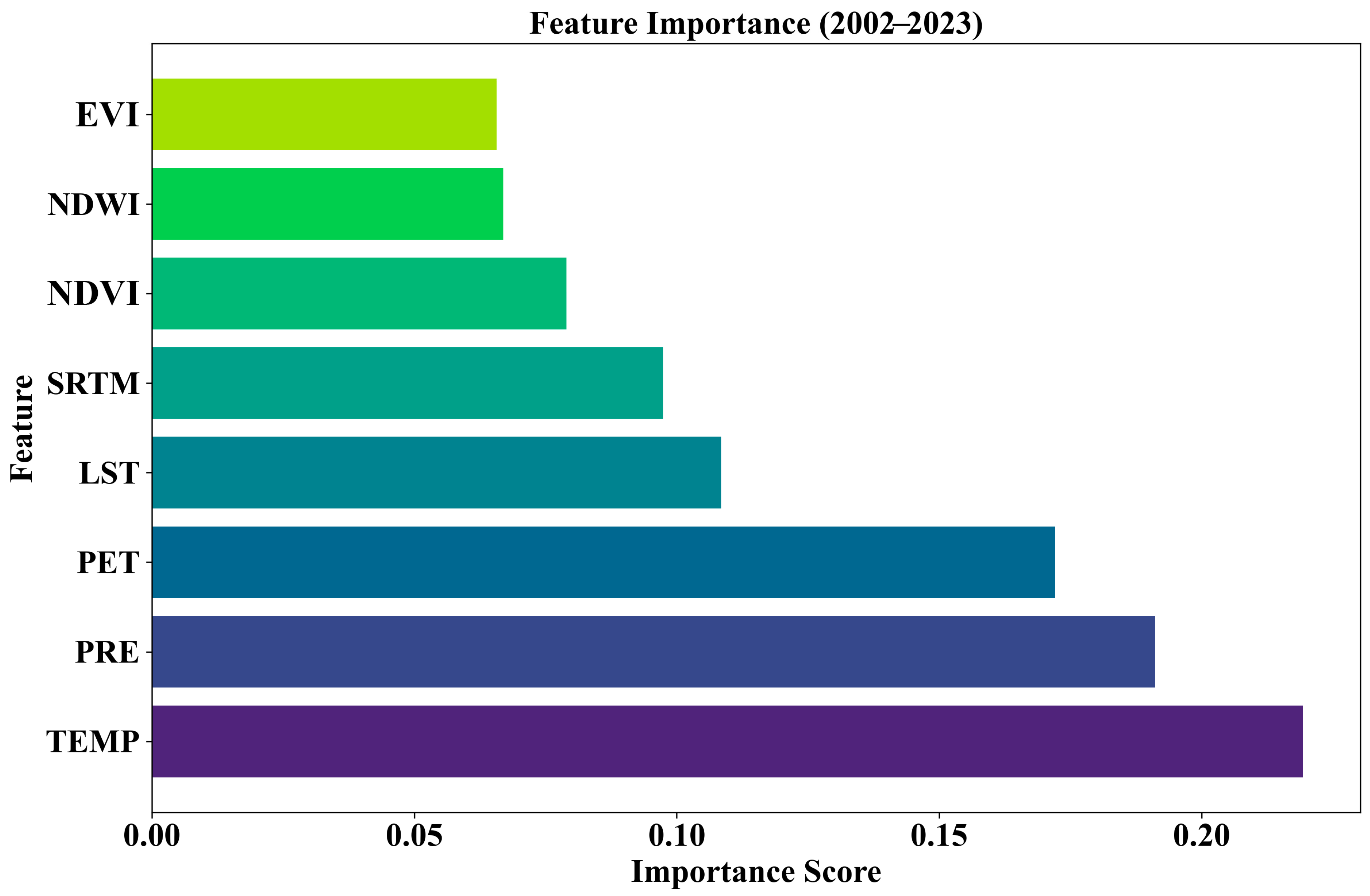
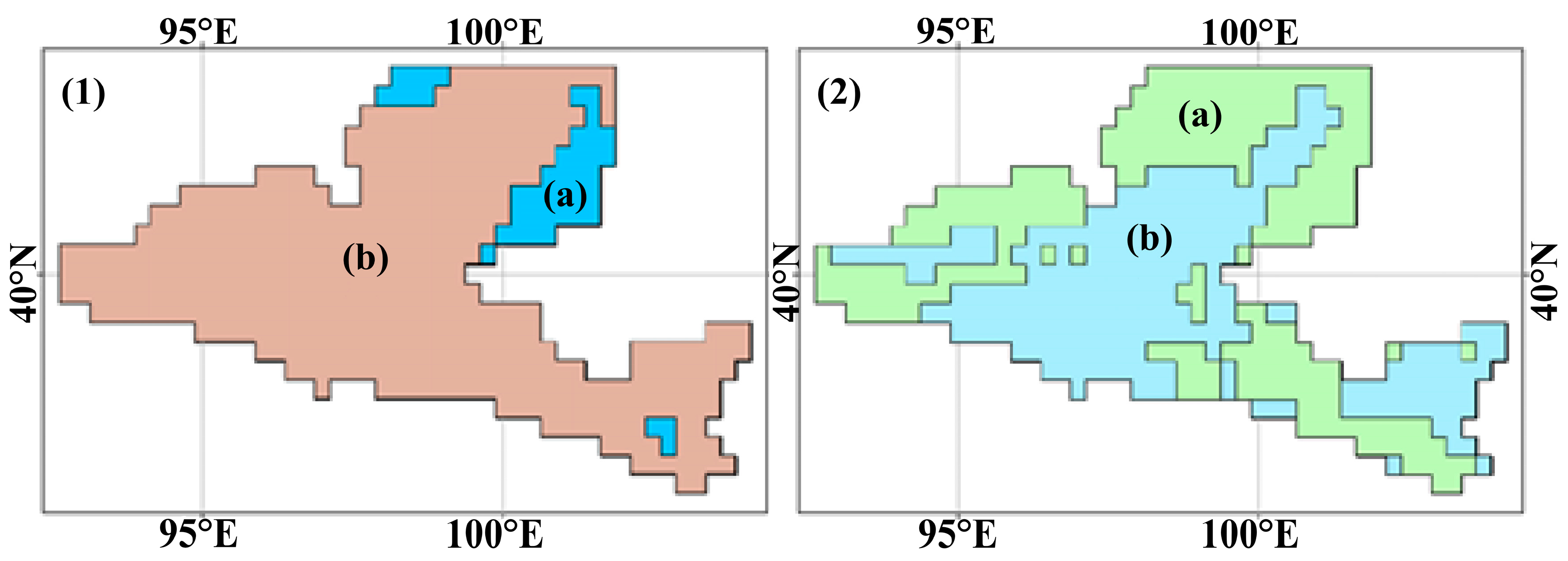
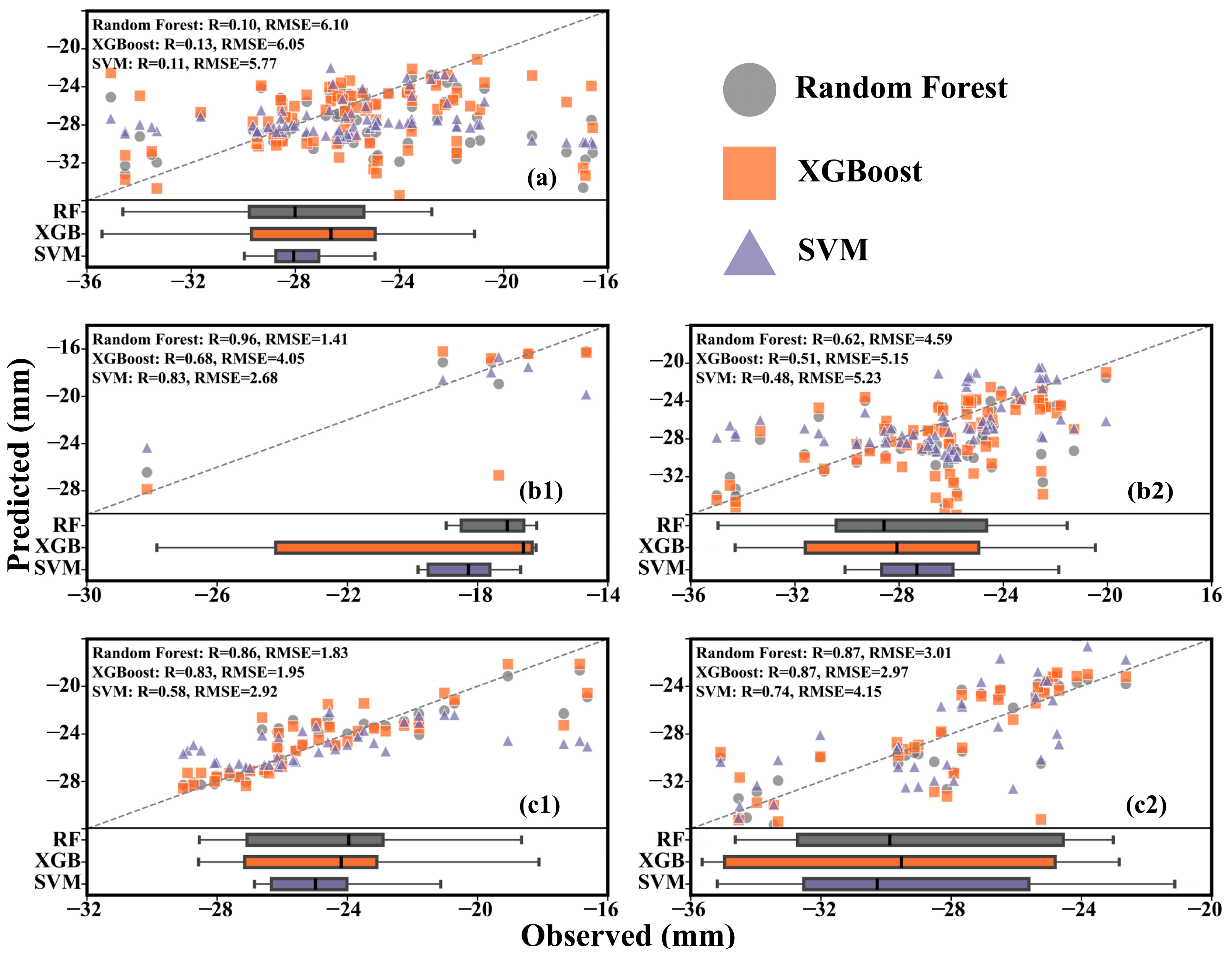

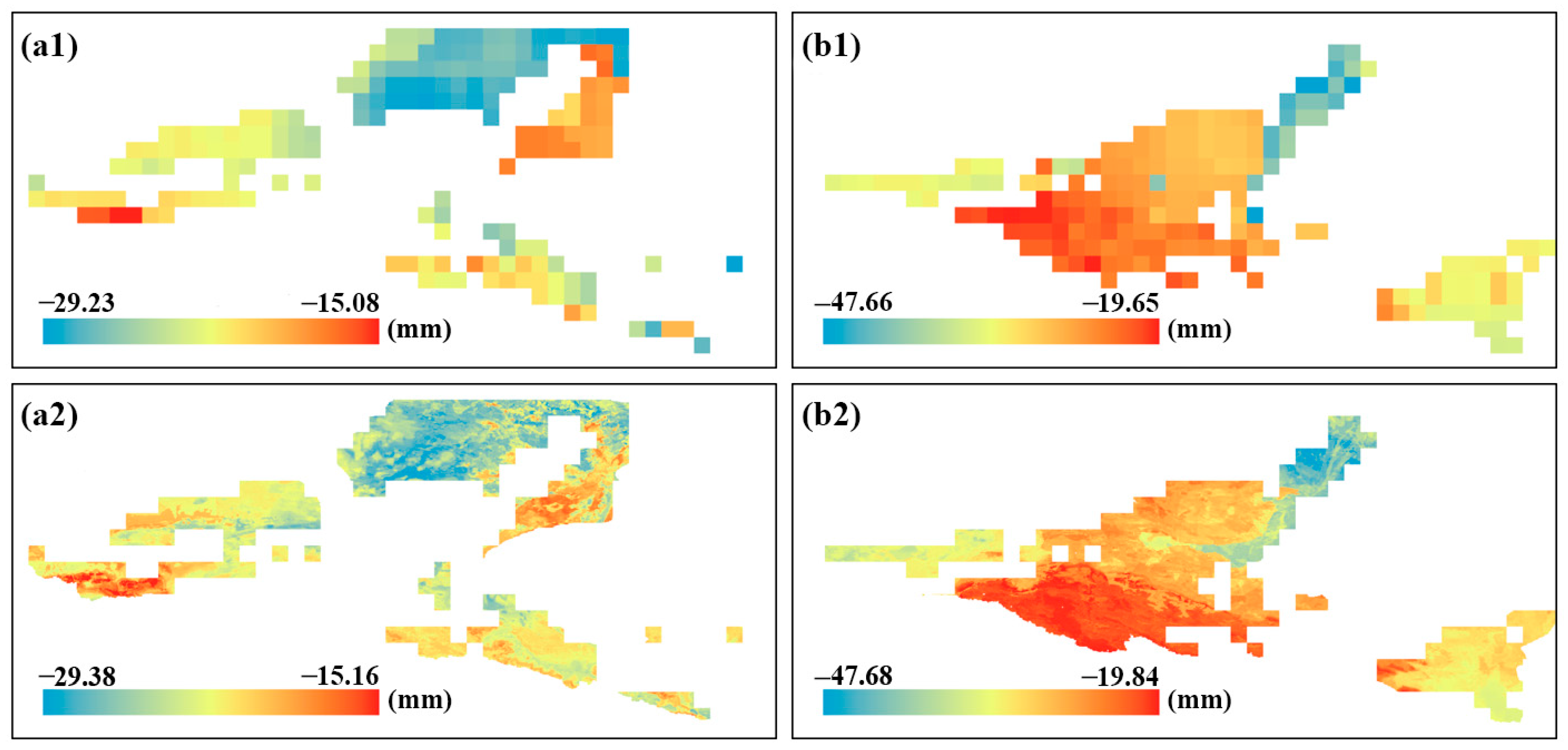

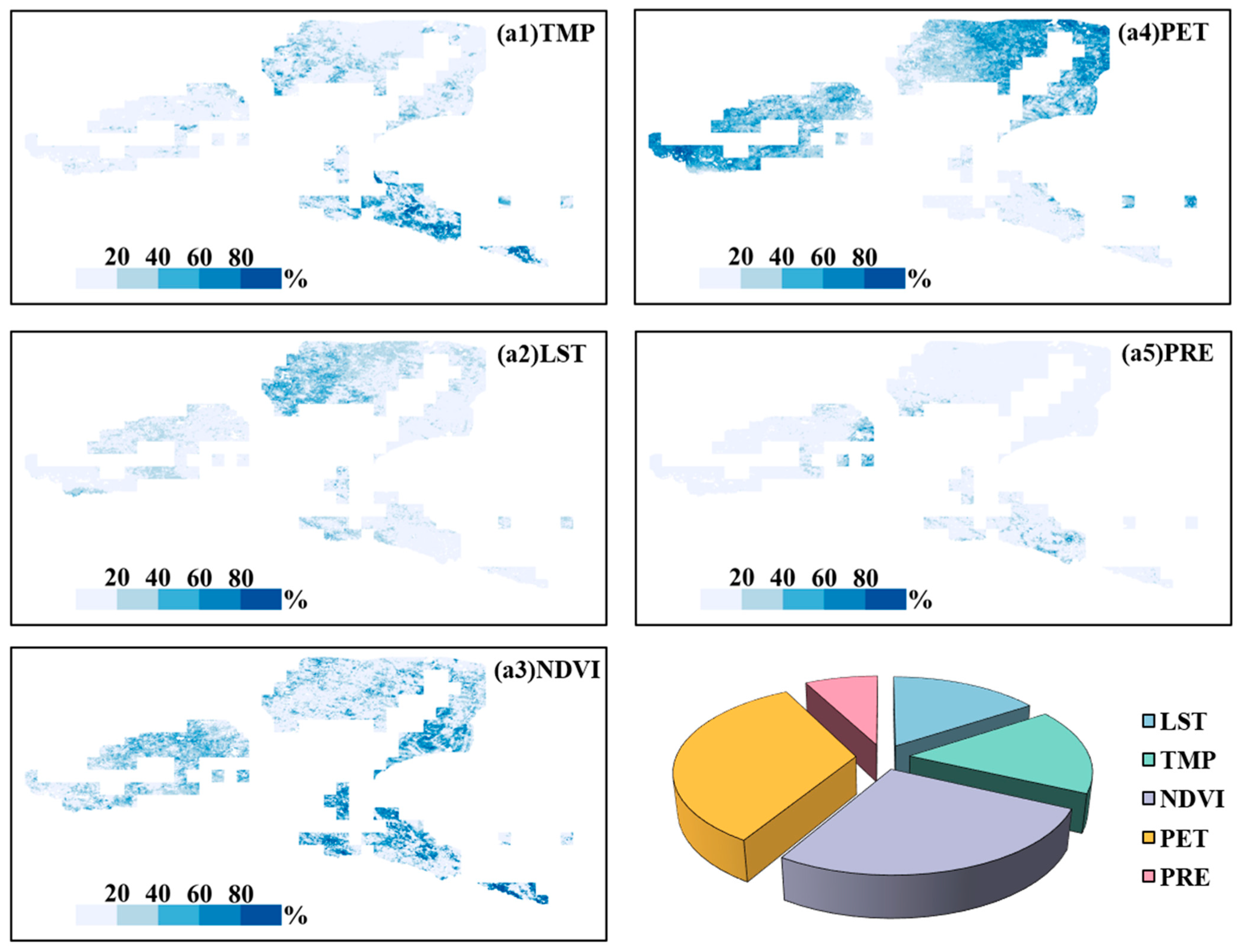
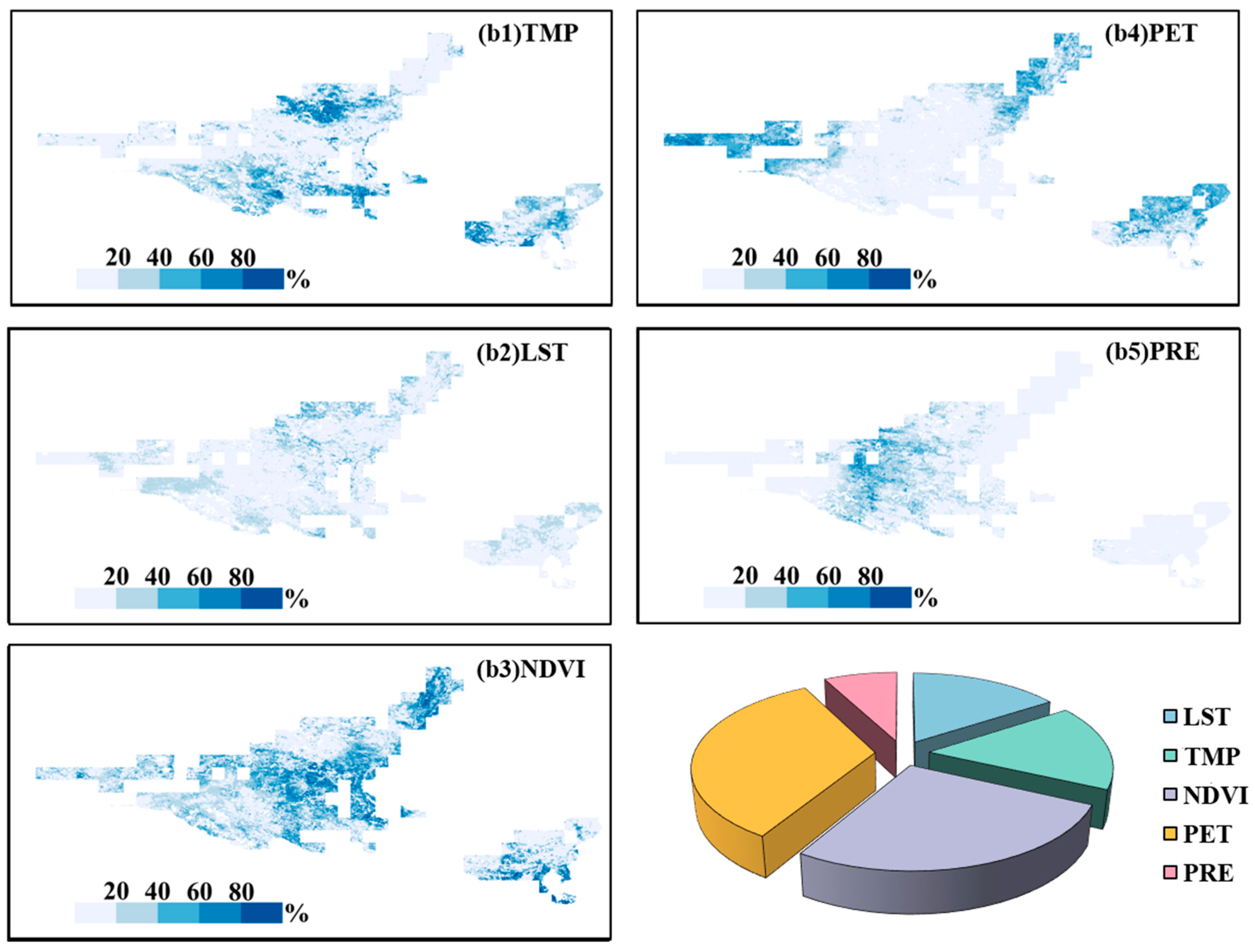
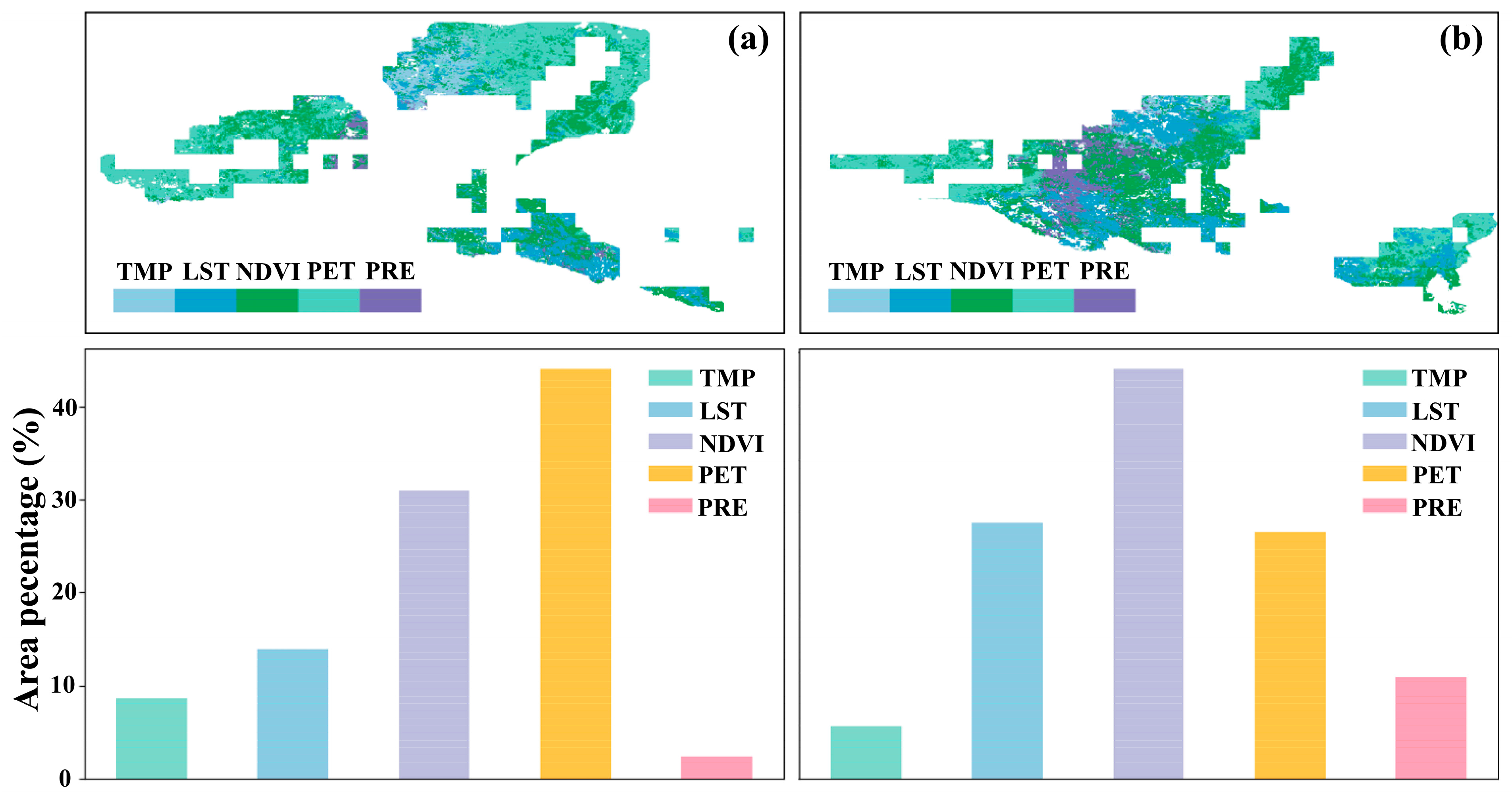
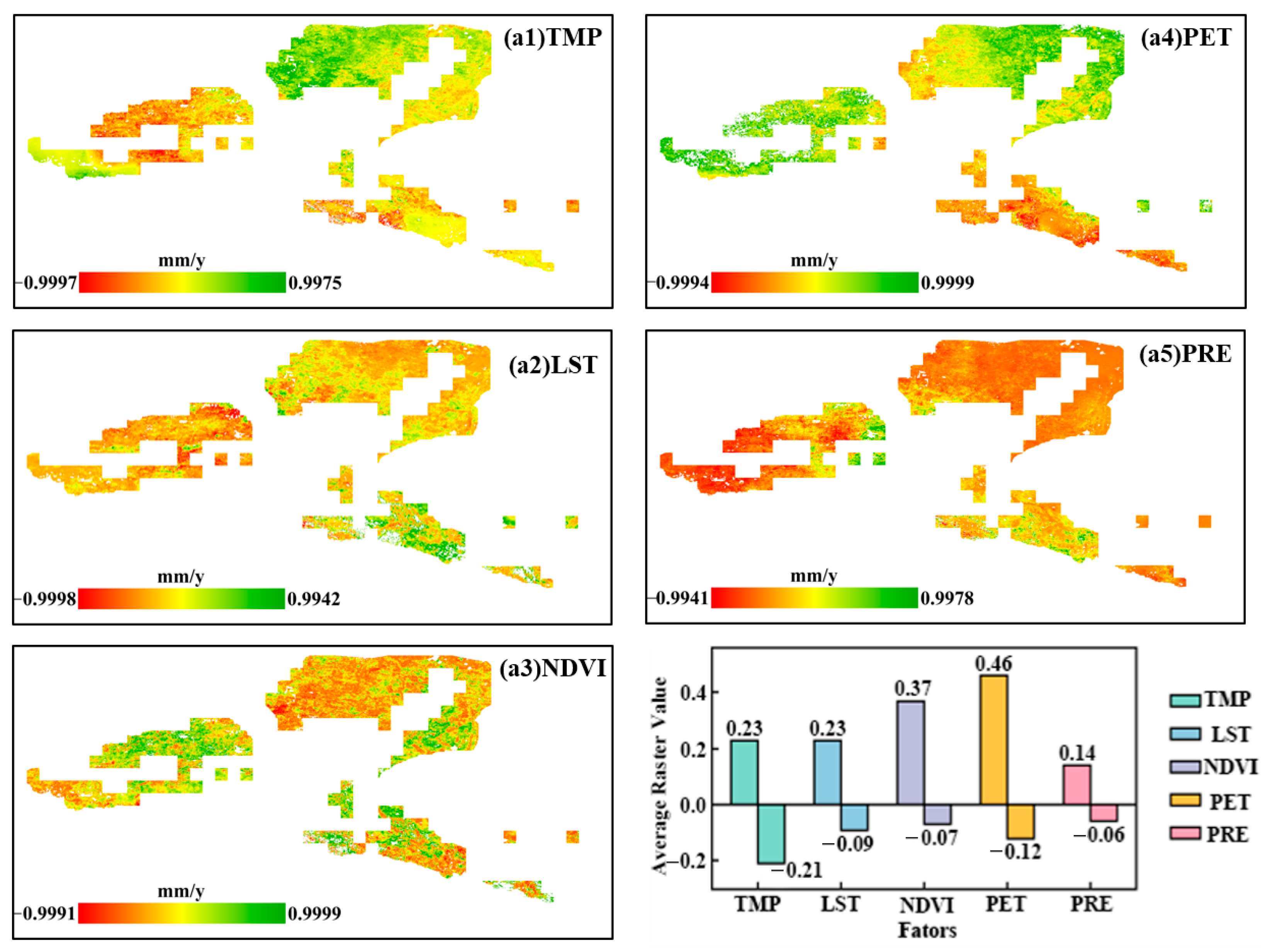
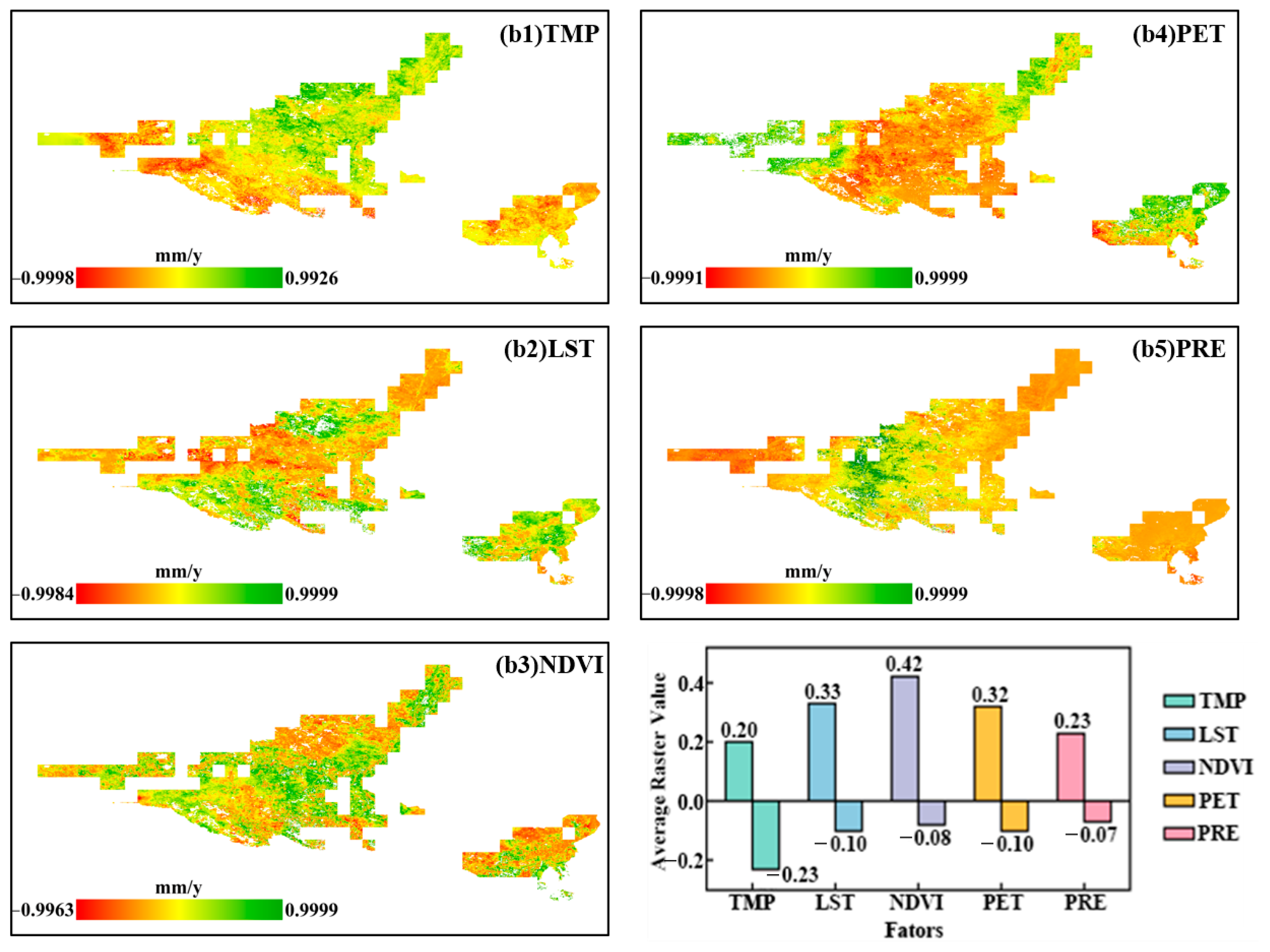
| Data | Data Source | Time Resolution | Spatial Resolution |
|---|---|---|---|
| GRACE | https://www2.csr.utexas.edu/grace/RL06_mascons.html (accessed on 31 October 2024) | Monthly | 0.25° × 0.25° |
| GLDAS | https://earthdata.nasa.gov/ (accessed on 31 October 2024) | Monthly | 0.25° × 0.25° |
| TEMP | https://data.tpdc.ac.cn/home (accessed on 31 October 2024) | Monthly | 1 km × 1 km |
| PRE | https://data.tpdc.ac.cn/home (accessed on 31 October 2024) | Monthly | 1 km × 1 km |
| ET | https://data.tpdc.ac.cn/home (accessed on 31 October 2024) | Monthly | 1 km × 1 km |
| NDVI | https://lpdaac.usgs.gov/products/mod13q1.061/ (accessed on 31 October 2024) | 16 day | 250 m × 250 m |
| LST | https://lpdaac.usgs.gov/products/mod11a2v061/ (accessed on 31 October 2024) | 8 day | 1 km × 1 km |
| DEM | https://developers.google.com/earth-engine/datasets/catalog/USGS_SRTMGL1_003 (accessed on 31 October 2024) | Static | 30 m × 30 m |
| EVI | https://lpdaac.usgs.gov/products/mod13q1.061/ (accessed on 31 October 2024) | 16 day | 250 m × 250 m |
| NDWI | https://lpdaac.usgs.gov/products/mod13q1.061/ (accessed on 31 October 2024) | 16 day | 250 m × 250 m |
| WELL | China Groundwater Level Yearbook | Monthly | - |
| Model | Parameter | Range |
|---|---|---|
| RF | n_estimators | 100–500 |
| max_depth | 5–50 | |
| min_samples_split | 2–20 | |
| min_samples_leaf | 1–10 | |
| max_features | ‘sqrt’, ‘log2’, None | |
| bootstrap | True, False | |
| XGBoost | n_estimators | 100–500 |
| learning_rate | 1 × 10−4–1 × 10−1 | |
| max_depth | 3–20 | |
| gamma | 0–5 | |
| subsample | 0.5–1 | |
| colsample_bytree | 0.5–1 | |
| SVM | C | 0.1–20 |
| Kernel | ‘linear’, ‘rbf’, ‘poly’ | |
| Gamma | ‘scale’, ‘auto’ |
| Clusters | K-Means Clustering (DTW) | Hierarchical Clustering (DTW) | K-Means Clustering (ED) | Hierarchical Clustering (ED) |
|---|---|---|---|---|
| 2 | 0.32 | 0.48 | 0.31 | 0.38 |
| 3 | 0.29 | 0.42 | 0.28 | 0.32 |
| 4 | 0.23 | 0.41 | 0.21 | 0.22 |
| Region | Wells | R with GRACE GWSA Before Downscaling | Average Value of r with GRACE Downscaled GWSA | ||||
|---|---|---|---|---|---|---|---|
| Max | Min | Mean | Max | Min | Mean | ||
| Region (a) | 72 | 0.95 | −0.44 | 0.47 | 0.97 | −0.44 | 0.54 |
| Region (b) | 90 | 0.84 | −0.50 | 0.40 | 0.84 | −0.42 | 0.45 |
Disclaimer/Publisher’s Note: The statements, opinions and data contained in all publications are solely those of the individual author(s) and contributor(s) and not of MDPI and/or the editor(s). MDPI and/or the editor(s) disclaim responsibility for any injury to people or property resulting from any ideas, methods, instructions or products referred to in the content. |
© 2025 by the authors. Licensee MDPI, Basel, Switzerland. This article is an open access article distributed under the terms and conditions of the Creative Commons Attribution (CC BY) license (https://creativecommons.org/licenses/by/4.0/).
Share and Cite
Xue, H.; Wang, H.; Dong, G.; Li, Z. Spatial Downscaling of GRACE Groundwater Storage Based on DTW Distance Clustering and an Analysis of Its Driving Factors. Remote Sens. 2025, 17, 2526. https://doi.org/10.3390/rs17142526
Xue H, Wang H, Dong G, Li Z. Spatial Downscaling of GRACE Groundwater Storage Based on DTW Distance Clustering and an Analysis of Its Driving Factors. Remote Sensing. 2025; 17(14):2526. https://doi.org/10.3390/rs17142526
Chicago/Turabian StyleXue, Huazhu, Hao Wang, Guotao Dong, and Zhi Li. 2025. "Spatial Downscaling of GRACE Groundwater Storage Based on DTW Distance Clustering and an Analysis of Its Driving Factors" Remote Sensing 17, no. 14: 2526. https://doi.org/10.3390/rs17142526
APA StyleXue, H., Wang, H., Dong, G., & Li, Z. (2025). Spatial Downscaling of GRACE Groundwater Storage Based on DTW Distance Clustering and an Analysis of Its Driving Factors. Remote Sensing, 17(14), 2526. https://doi.org/10.3390/rs17142526





